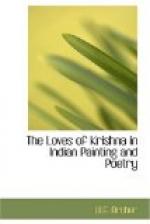lover. There is a tendency for the older Krishna
to disparage the younger. Krishna the prince’s
subsequent meetings with the cowgirls are shown as
very different from his rapturous encounters with them
in the forest and the fact that his later career involves
so sharp a separation from them indicates that the
whole episode was somewhat frowned upon. This
is especially evident from the manner in which Krishna
addresses the cowgirls when they meet him during the
eclipse of the sun. By this time he has become
an ardent husband constantly satisfying his many wives.
He is very far from having abjured the delights of
the flesh. Yet for all his former loves who long
for him so passionately he has only one message.
They must meditate upon him in their minds. No
dismissal could be colder, no treatment more calculatingly
callous. And even the accounts of Krishna’s
love-making reflects this bias. The physical charms
of the cowgirls are minimized and it is only the beauty
of Rukmini which is stressed. It is clear, in
fact, that however much the one tradition involved
a break with morals, the second tradition shrank from
countenancing adultery and it was this latter tradition
which commanded the authors’ approval. Finally,
on one important issue, the
Purana as a whole
is in no doubt. Krishna’s true consort
is Rukmini. That Krishna’s nature should
be complemented by a cowgirl is not so much as even
considered. The cowgirls are shown as risking
all for Krishna, as loving him above all else but none
is singled out for mention and none emerges as a rival.
In this long account of Krishna’s life what
is overwhelmingly significant is that the name of his
supreme cowgirl love is altogether omitted.
V
THE KRISHNA OF POETRY
(i) The Triumph of Radha
During the next two hundred years, from the tenth
to the twelfth century, the Krishna story completely
alters. It is not that the facts as given in
the Bhagavata Purana are disputed. It is
rather that the emphasis and view-point are changed.
Krishna the prince and his consort Rukmini are relegated
to the background and Krishna the cowherd lover brought
sharply to the fore. Krishna is no longer regarded
as having been born solely to kill a tyrant and rid
the world of demons. His chief function now is
to vindicate passion as the symbol of final union
with God. We have already seen that to Indians
this final union was the sole purpose of life and
only one experience was at all comparable to it.
It was the mutual ecstasy of impassioned lovers.
’In the embrace of his beloved, a man forgets
the whole world—everything both within
and without; in the same way, he who embraces the
Self knows neither within nor without.’[46] The
function of the new Krishna was to defend these two
premises—that romantic love was the most
exalted experience in life and secondly, that of all
the roads to salvation, the impassioned adoration




